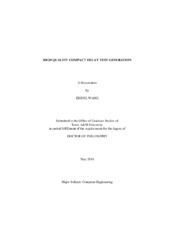| dc.contributor.advisor | Walker, Duncan M. | |
| dc.creator | Wang, Zheng | |
| dc.date.accessioned | 2011-08-08T22:48:11Z | |
| dc.date.accessioned | 2011-08-09T01:28:53Z | |
| dc.date.available | 2011-08-08T22:48:11Z | |
| dc.date.available | 2011-08-09T01:28:53Z | |
| dc.date.created | 2010-05 | |
| dc.date.issued | 2011-08-08 | |
| dc.date.submitted | May 2010 | |
| dc.identifier.uri | https://hdl.handle.net/1969.1/ETD-TAMU-2010-05-7976 | |
| dc.description.abstract | Delay testing is used to detect timing defects and ensure that a circuit meets its
timing specifications. The growing need for delay testing is a result of the advances in
deep submicron (DSM) semiconductor technology and the increase in clock frequency.
Small delay defects that previously were benign now produce delay faults, due to
reduced timing margins. This research focuses on the development of new test methods
for small delay defects, within the limits of affordable test generation cost and pattern
count.
First, a new dynamic compaction algorithm has been proposed to generate
compacted test sets for K longest paths per gate (KLPG) in combinational circuits or
scan-based sequential circuits. This algorithm uses a greedy approach to compact paths
with non-conflicting necessary assignments together during test generation. Second, to
make this dynamic compaction approach practical for industrial use, a recursive learning
algorithm has been implemented to identify more necessary assignments for each path,
so that the path-to-test-pattern matching using necessary assignments is more accurate.
Third, a realistic low cost fault coverage metric targeting both global and local delay
faults has been developed. The metric suggests the test strategy of generating a different
number of longest paths for each line in the circuit while maintaining high fault coverage.
The number of paths and type of test depends on the timing slack of the paths under this
metric. Experimental results for ISCAS89 benchmark circuits and three industry circuits
show that the pattern count of KLPG can be significantly reduced using the proposed
methods. The pattern count is comparable to that of transition fault test, while achieving
higher test quality. Finally, the proposed ATPG methodology has been applied to an
industrial quad-core microprocessor. FMAX testing has been done on many devices and
silicon data has shown the benefit of KLPG test. | en |
| dc.format.mimetype | application/pdf | |
| dc.language.iso | en_US | |
| dc.subject | Delay Test, ATPG, Test Compaction | en |
| dc.title | High Quality Compact Delay Test Generation | en |
| dc.type | Thesis | en |
| thesis.degree.department | Computer Science and Engineering | en |
| thesis.degree.discipline | Computer Engineering | en |
| thesis.degree.grantor | Texas A&M University | en |
| thesis.degree.name | Doctor of Philosophy | en |
| thesis.degree.level | Doctoral | en |
| dc.contributor.committeeMember | Chen, Jianer | |
| dc.contributor.committeeMember | Mahapatra, Rabinarayan | |
| dc.contributor.committeeMember | Shi, Weiping | |
| dc.type.genre | thesis | en |
| dc.type.material | text | en |


